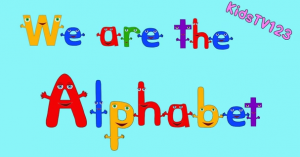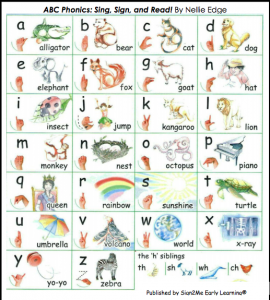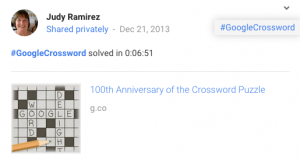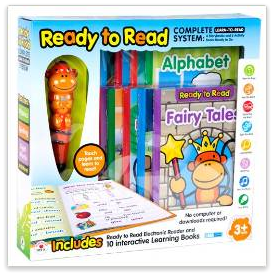Here is an educational product called READY TO READ – COMPLETE SYSTEM for Ages 3+. Included are 4 storybooks, 6 activity books, electronic reader (no computer or downloads required)… all ready to go… sold at Costco in 2011 for $29.99.
Was this a bargain for the parents who bought it or not? Advertising and actual contents don’t always match. My analysis yields both “thumbs-up” and “thumbs-down” as follows:
HEAR THE PAGE – Thumbs up for these read-alouds.
HEAR THE WORD – Thumbs up for vocabulary pronunciations.
SOUND-OUT THE WORD – Thumbs waaaaay down for explicit sound-parsing.
SPELL THE WORD – Thumbs down for sound-letter correspondences.
LOOK AND FIND – Thumbs up for this game technology.
WORD PLAY – Thumbs up for learning fun.
HEAR THE MUSIC – Thumbs up for music, always.
SING ALONG – Thumbs waaaaay up, if kids will actually sing along.
Remember: Good orange juice can’t come from bad oranges.
This product may seem a great value, costing the price of one family meal in a cheap restaurant, but if it provides misinformation resulting in mental confusion, you may be actually setting yourself up for later remediation costs. Here are my complaints:
1) This program’s “Sound-out the word” feature has the status-quo bias towards visual input (ABCs) rather than auditory input (speech sounds), which includes several errors. For starters, children don’t HEAR letters.
2) This program creates letter-sound ambiguity, but a simple remedy (as shown in **new instructions**) is to say the word “Letter” before each letter name. Example: Letter /I/. There can be no confusion about sound-alike concepts: /I/-eye; /O/-oh; /P/-pea; /T/-tea; and /U/-you; etc.
3) This program distorts the pronunciation of all consonants by adding “–uhh” to the basic sound, as in ‘puhh’ – ‘buhh’ – ‘tuhh’ – ‘duhh’ – ‘chuhh’ – ‘juhh’ – ‘cuhh’ – ‘guhh’ – etc.
4) This program uses a Letters-to-Sounds approach, defaulting to conventional phonics names for vowel sound-units: Short Vowel-A or Short-A Sound [V01] animal; Long Vowel-A or Long-A Sound [V06] ace; Soft-C [C28] city; Hard-C [C22] cat; Soft-G [C21] giraffe; Hard-G [C23] goose, etc.
5) This program fails to make a proper distinction between [V09] juice/glue and [C39+V09] cube/use/uniform.
6) This program wrongly calls the following sounds “blends”: /sh/shirt, /ch/chin, /th/these, theater; /wh/who, etc.
When you take a deeper look at relevant instructions for each of this program’s six activity books (shown below), it is questionable whether the READY TO READ product is meritorious.
__________________________________________________
Alphabet • READY TO READ • ISBN 978-1-4508-2066-0
The monkey gives instructions and starts activities.
(Notice **new instructions** which differentiate letters and sounds.)
A, B, C, D, E, F >> “Touch the red letters to play.”
**Apple starts with Letter /A/.**
**Find the letter that comes right after Letter /D/.**
G, H, I, J, K >> “Touch the red letters to play.”
**Find the green Letter /I/** vs. Find the green eye.
L, M, N, O, P >> “Touch the red letters to play.”
**Find the green Letter /O/** vs. Find the green oh.
**Find the green Letter /P/** vs. Find the green pee/pea.
Q, R, S, T, U >> “Find the match.”
**The first sound in train is spelled Letter /T/** vs. Train starts with tea.
**The first sound in umbrella is spelled Letter /U/** vs. Umbrella starts with you.
V, W, X, Y, Z >> “Touch the red letters to play.”
**Find the orange Letter /V/.**
A to Z >> “Touch each letter of the alphabet in order.”
What comes next? >> “Touch a picture to play.”
**Find the letter that spells the first sound in apple** vs. Find the letter that starts the word apple.
**Find the letter that spells the first sound in fish… hat… kite…** etc.
Balloon, Balloon/ Family Reunion/ Ice Cream/ Lock and Key >>
**Find the matching lowercase Letter /a/.**
**This is the uppercase Letter /E/.**
**This is the lowercase Letter /j/** vs. This is the lowercase jay?
Make a Match >> “What other picture starts with ___?”
**The first sound in monkey is spelled Letter /M/. Find the picture that shows lowercase Letter /m/.**
Time to Paint >> “Touch a paint can to play.”
**This is uppercase Letter /P/. Find the lowercase Letter /p/.**
Tic-Tac-Toe >> “Find the blue s.”
**Find the blue Letter /s/. Find the picture of a salad. The first sound in salad is spelled Letter /s/.**
**This is the uppercase Letter /A/. This is the lowercase Letter /m/.**
Time to Pack! >> “Things that start with v go in the van. Find two things that go in the van.”
**Van. The first sound in van is spelled Letter /v/.**
(Whale. The first sound in whale is not spelled Letter /w/.)
Driving the Alphabet >> “Find the matching lowercase letter.”
**Letter /X/. Find the matching lowercase Letter /x/.**
Letter Scramble >> “Touch an uppercase letter to play. Find the matching lowercase letter.”
**Letter /D/. Find the matching lowercase Letter /d/.**
Lowercase Letter Train >> “Touch a circle on the train. Then touch a letter that goes in the circle.”
**Letter /a/. Letter /b/. Letter /c/.** etc.
__________________________________________________
Rhyming Words • READY TO READ • ISBN 978-1-4508-2063-9
The monkey gives instructions and starts activities.
These are guessing games if the child can’t already read.
Rhyming Pictures >> “Touch the first picture in each row, then find the picture that rhymes.”
Rhyme Time-1 >> “Touch the first picture in each row, then find the picture that rhymes.”
“Flag and bag rhyme” is garbled and sounds like “Flag it bag rye.” “10” sounds like “Ted.”
Rhyme Time-2 >> “Find the ___. Find the picture that rhymes with ___.”
Rhyme or Not? >> “___, ___, ___. Which word doesn’t rhyme?”
Rhyme Me a Poem >> “Find the ___.”
Tips for sounding-it out: Short Vowel-A, Short Vowel-I, Short Vowel-O, Short Vowel-U,
Long Vowel-A, Long Vowel-E, Long Vowel-I, Long Vowel-O; Silent-e rule; /th/-blend;
plus all individual sounds have an extra ‘–uhh’ as in ‘muhh-sound’ – ‘buhh-sound’ – ‘luhh-sound’ –
‘nuhh-sound’ – ‘huhh-sound’ – ‘cuhh-sound’ – ‘suhh-sound’ – ‘tuhh-sound’ – etc.
A Fat Cat >> “Find the ___. Find the letter that starts the word ___.”
WordsAhead would say: Find the letter that spells the first sound in rat.
The Man Ran >>“Touch the picture to play. Touch the word that matches the picture.”
Ted Men and a Head? (or so it sounds…) >> “Touch the word that finishes each riddle.”
The Pet Is Wet >> “Touch the word that finishes each rhyme.”
The Pin Is Thin/The Ring Is the Thing >> “Find each word in the story that uses ___ word-ending.”
“I am pretty. You wear me on your finger. I am a…
(answer) SWING. YES. You sit on a swing and it moves back and forth.”
“You sit on me. You move me back and forth. I am a…
(answer) YES. A pretty thing you wear on your finger is a ring!”
A Cub in a Tub >> “___. Which set of letters ends this word?”
Don’t Block the Clock >> “Find the picture, find the word.”
A Sad Fad >> “Find all the keys with words that end in ___.”
Stay and Play >> “Touch each word that ends in ___.”
Oh Well >> “Find each word in the story that uses the ___ word-ending.”
(spoken) the shell fell in a well vs. (printed) fell into the well
Tips for sounding-it out: /sh/-blend for the word shell; /wh/-blend for the word who
Word Switch >> “Where should the ___ go to make the word ___?”
Family Friends >> “Touch two words that end in /ock/.”
__________________________________________________
Consonants and Vowels • READY TO READ • ISBN 978-1-4508-2065-3
The monkey gives instructions and starts activities.
What’s That Sound? >> “Touch a picture that begins with…”
Distorted pronunciations: ‘buhh’ – ‘cuhh’ – ‘duhh’ – ‘fuhh’ – ‘guhh’
Sounds Tasty! >> “Touch the letter you hear at the beginning of this word.”
You won’t HEAR letters; you SEE letters. Sounds are distorted by adding ‘–uhh’.
A Sound Match >> “Touch a picture that begins with…”
Distorted pronunciations: ‘puhh’ – ‘cuhh’ – ‘ruhh’ – ‘suhh’ – ‘tuhh’
What Wonderful Sounds! >> “Touch the letter you hear at the beginning of this word.”
The first sounds in the word x-ray aren’t /ks/.
C Is for Cat and City >> “Touch all the pictures that start with Soft-C.”
Phonics terminology: Soft-C [C28]; Hard-C [C22]
Ready, Set, Go! >> “What picture starts with the Soft-G sound?”
Phonics terminology: Hard-G [C23]; Soft-G [C21]
Letter Match >> “Touch a picture that begins with…”
‘huhh’ – ‘puhh’ – ‘nuhh’ – ‘tuhh’ – ‘buhh’ – ‘guhh’ – ‘suhh’ – ‘zuhh’… these are all distorted sounds.
Name That Sound! >> “Touch the letter you hear at the beginning of this word.”
Same of Different? >> “Touch the word that begins with a different letter than the other two.”
This is a visual discrimination activity.
Short Vowel Aa, Ee, Ii, Oo, Uu >> “Which picture does not start with Short Vowel ___?”
Auditory discrimination activities for [V01], [V05], [V02], [V03], [V04]
Over the River! >> “Touch the words in the picture having short vowels.”
Shhh! Silent Ee >> “Touch the letter that makes the long vowel-sound for this word.”
V06/a_e/, V07/i_e/, V08/o_e/ How about /ee_e/ cheese or /u_e/ rule or /oo_e/ choose, etc.
Long Vowel Aa, Ee, Ii, Oo >> “Touch each picture that has the Long-__ sound.”
Auditory discrimination activities for [V06], [V10], [V07], [V08]
Long Vowel Uu >> “Touch all the pictures on the page that have the Long-U sound.”
[C39+V09]: cube, use, uniform
Looking for Long Vowels >> “Touch all the pictures on the page that have long vowels.”
__________________________________________________
Consonant Blends and More Vowels • READY TO READ • ISBN 978-1-4508-2064-6
The monkey gives instructions and starts activities.
Shhh. Check It Out! >> “Touch the consonant blend that begins this word.”
Warning! /sh/ and /ch/ are not consonant blends!
A consistent error is that an extra “–uhh” is added to all pronunciations: ‘shuhh’ and ‘chuhh’
Love Those Shoes! >> “Touch nine words in the story that begin with th ‘thuhh’.”
Sound distortion: ‘thuhh’
The word tried starts with a consonant blend spelled /tr/.
The word are does not use the Short Vowel-O, but rather [V11].
Thanks a Lot! >> “Touch the word in the box that spells theater.” (Say what?!)
Let’s Blend/ Greasy Fries/ Train Tracks/ Have a Slice! >>
All have an extra “–uhh” added to the pronunciations:
‘cruhh’ – ‘bruhh’ – ‘druhh’ – ‘gruhh’ – ‘fruhh’ – ‘truhh’ – ‘pruhh’ – ‘sluhh’
Blend Review >> “Touch the mailbox that has a word starting with ___.”
This activity is about letter-matching.
Balloon Blends >> “Touch the girl’s shirt with the same consonant blend.”
Another visual activity, matching graphemes.
Snap to It!/ Star Power/ Be a Spy!/ Ready, Set, Smile!/ A String of Blends >>
Letter-matching games for ‘snuhh’ – ‘stuhh’ – ‘spuhh’ – ‘smuhh’ – ‘struhh’ – ‘spruhh’
Meet the Knight! >> “Touch six words in the story that begin with /kn/ – ‘nuhh’ .”
Tips for sounding-out: Short Vowel-A, Short Vowel-I, Short Vowel-O, Short Vowel-U,
Long Vowel-A, Long Vowel-E, Long Vowel-I, Long Vowel-O
Blend Review >> “Touch the blend in the box that begins this word.”
Letter-matching for consonant blends. All are distorted with ‘–uhh’.
Oooo La La! >> “Touch the four words that have the [V09]-sound heard in broom.”
It’s a Cow! >> “Touch the correct spelling of this word.”
This is a guessing game! [V13] (Happily notice they didn’t pronounce it ‘ow-uhh’.)
R In Charge >> “Touch all fourteen words that have Letter /r/.”
Let it Snow! >> “Touch the six words that have the Long-O sound heard in snow.”
Compare [V08] and [V13], both spelled Letters /ow/.
Our House! >> “Touch the five words that make the /ou/ [V13] sound heard in cloud.”
Do Your Laundry! >> “Touch the six words that make the /au/ [V11] sound heard in laundry.”
It isn’t always the /au/ sound:
Notice the advantages of using the codes from WordsAhead’s Sound Map.
__________________________________________________
Syllables and Sentences • READY TO READ • ISBN 978-1-4508-2061-5
The monkey gives instructions and starts activities.
My most positive evaluation for this book is to observe that pages contain colorful guessing-games.
Keep on Track! >> “Touch the two syllables that make up the word, in order.”
WordsAhead divides the word letter: C37 V05 • C18 V15
How Many Syllables? >> “Find the word with one syllable.”
What Is It? >> “Touch a picture, then find the noun it matches.”
A Day Trip >> “Touch the word that completes the sentence.”
What’s My Name? >> “Touch the picture that goes with the proper noun.”
Two Together >> “Find the two words that make the compound word.”
More Than One >> “Touch a picture, then find the plural noun that matches.”
More Than One–Again >> “Touch the circle with the ending that makes it plural.”
I Can Do It! >> “Touch the word that completes each sentence.”
I Can Do It Again! >> “Touch the verb in each sentence.”
What Did You Do? >> “Touch the past tense verb that completes the sentence.”
What Else Did You Do? >> “Touch the past tense verb that completes the sentence.”
To Be or Not To Be? >> “Touch a sentence that says that one person is happy right now.”
Pronoun Practice >> “Touch a picture, then match it to its pronoun.”
Let’s Agree >> “Touch the word that completes each sentence.”
No, No, No >> “Touch the word that completes each sentence.”
Shorties >> “Touch the contraction made from is and not.”
Sounds the Same >> “Touch a word to hear what it means.”
Look-Alikes >> “Touch the picture that matches the blue word in each sentence.”
Opposites >> “Touch a word or picture, then find its opposite.”
WordsAhead alleges that, even with the “see-say” strategy for new words,
these lessons are irrelevant for 3-, 4- or 5-year-olds.
__________________________________________________
Sight Words • READY TO READ • ISBN 978-1-4508-2062-2
The monkey gives instructions and starts activities.
Words to Know >> “The sight word the is used four times in the story. Touch all four words.”
Tips for sounding-out words: [V04]; ‘buhh’ sound; ‘huhh’ sound; Short Vowel-A [V01];
Short Vowel-O [V03]; ‘puhh sound’; ‘huhh sound’; ‘tuhh sound’; Long Vowel-E; ‘fuhh sound’;
And, Or, But >> “Touch the word missing from the sentence.”
This, That, These, Those >> “The sight words this, that, these and those are used six times in the story. Find all.”
Sounding-out words: ‘th’ blend; Short Vowel-I [V02]; ‘muhh sound’; ‘nuhh sound’; ‘huhh sound’; Short Vowel-O [V11]; ‘puhh sound’; Short Vowel-A [V01]; ‘guhh sound’; ‘tuhh sound’; ‘wuhh sound’;
‘cuhh sound’; ‘buhh sound’; ‘ruhh sound’; ‘juhh sound’
At, To, In, On >> “Touch the word that fills in the blank.”
For, From, Off, On >> “Touch the word ___ in a sentence.”
With, By, Over, Into >> “Touch the word missing from the sentence.”
What Is the Question? >> “Touch the word ___ in a sentence.”
I, You, We >> “Touch the word in the box that describes people.”
He, She, It, They >> “Touch the word that takes the place of another word.”
My, Your, Her, His, Their >> “Touch the word in the box that spells ___.”
Comparing Words >> “Touch a sentence to play.”
Good, Better, Best >> “Touch the word ___ in a sentence.”
Some, Many, Most >> “Touch the comparing-word in the sentence.”
Number Words >> “How many grasshoppers? Touch the number word.”
Color Words >> “What color is the apple? Touch the word.”
Feeling Words >> “Touch the feeling word.”
Picture Words >> “Touch the word missing from the sentence.”
Action Words-1 >> “Touch the action word that goes with this picture.”
Action Words-2 >> “There is one action word in each sentence. Touch all four.”
Naming Words >> “Touch the word ___.”
Find the Name! >> “Touch the word ___.”
CONCLUSION:
Promising new products have yet to be created based on Typesetting Standards for 21st Century Educators.

 Shown here,
Shown here, 

